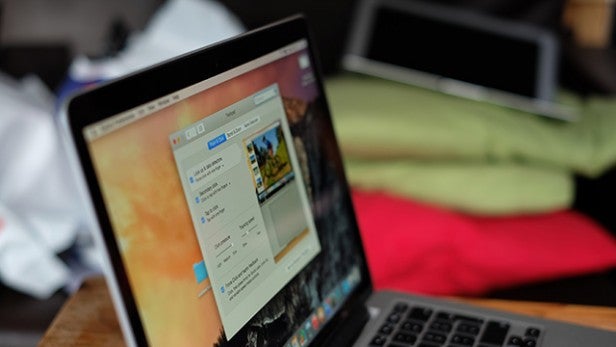

So when the time rolled around for me to kit myself out with a shiny new MacBook, you would think I headed straight for the 2019 MacBook Pro and paid like it was going out of fashion.
#2014 MACBOOK PRO VS 2015 SOFTWARE#
There’s enough innovation in both software and hardware to impress even the most curmudgeonly of cynics. Fitbit Versa 3Īpple does innovate, of course, and the latest MacBook Pro models - with monstrous eight-core i9 processors and Touch Bars aplenty - are no exception. The most recent MacBook Air, for comparison’s sake, lasted over 12 hours in this test. The 15-inch models lasted a respectable seven hours. The 2.6GHz 13-inch model lasted just over 10 hours in this test while the 2.8GHz model lasted just under nine and a half hours. We turned off Wi-Fi and set the screen brightness to 200 cd/m2. To test the battery life in these new portables, we looped a playlist of shows downloaded from the iTunes store. However, icons and text are terribly small when using these screens at native resolution-I assume Apple doesn’t think anyone in their right mind would want that kind of user experience.ġ3″ Retina MacBook Pro/2.4GHz (Late 2013)ġ3″ Retina MacBook Pro/2.6GHz (Late 2013)ġ5″ Retina MacBook Pro/2.0GHz (Late 2013)ġ5″ Retina MacBook Pro/2.3GHz (Late 2013)ġ3″ MacBook Air/1.4GHz, 256GB flash storage (Mid 2014) To use these displays at their native resolutions you’ll need to turn to a third-party utility such as EasyRes. Interestingly, the highest resolution setting on the 13-inch is 1680 by 1050 on the 15-inch, the highest available resolution setting is 1920 by 1280. The Best for Display setting is the default pixel-doubled resolution. If you want to change the resolution to fit more windows, images and documents on-screen, OS X’s Displays System Preferences allow you to choose between one of five available resolutions. Icons and user-interface elements are so sharp and clear that I sometimes find myself just admiring the contents of the Dock and menu bar. By default, both displays are set to pixel-doubled mode: 1280 by 800 for the 13-inch models, and 1440 by 900 on the 15-inch laptops.Īs mentioned in previous reviews, the Retina displays look great. The 15-inch MacBook Pro with Retina display sports a 15.4-inch IPS LED screen with a 2880-by-1800 resolution. The 13-inch Retina MacBook Pro has a glossy 13.3-inch (diagonal) IPS screen with LED backlighting and a native resolution of 2560 by 1600 pixels. Processor upgrades and flash-storage upgrades (up to 1TB) are also available at the time of purchase. The 13-inch models all come standard with a healthy 8GB of RAM, while the 15-inch models come with a very generous 16GB configuring the 13-inch model with 16GB costs an additional $200. RAM is soldered to the motherboard, so if you think you might ever need more than the stock amount, it’s important to configure your MacBook Pro with that extra RAM at the time of purchase. If fact, you’ll need a special Pentalobe screwdriver just to get the back cover off. The Retina MacBook Pro isn’t built with upgradability in mind.
#2014 MACBOOK PRO VS 2015 MAC#
The Late 2013 13-inch MacBook Pros were a couple of ounces lighter and and slightly thinner than previous models, and all Late 2013 models introduced Intel’s Haswell processors, Thunderbolt 2, and 802.11ac Wi-Fi to the Mac Book Pro line.Īs with the Late 2013 models, the 13- and 15-inch mid-2014 models include two USB 3.0 ports, two Thunderbolt 2 ports, an SDXC card slot, an HDMI port, and a headphone jack that supports the microphone and remote on headphones with an Apple-style inline remote/mic module. Unlike the rest of the mid-2014 models, which use integrated graphics (Intel Iris in the 13-inch models and Intel Iris Pro in the 15-inchers), the high-end 15-inch MacBook Pro adds discrete graphics in the form of an nVidia GeForce GT 750M GPU with 2GB of dedicated GDDR5 memory.Īside from the minor boosts in processor speed, and the low-end 13-inch model’s additional RAM, the latest MacBook Pros with Retina display stick with the design introduced in late 2013.

At $2499, the high-end 15-inch MacBook Pro is $100 less than the previous high-end model and has a 2.5GHz quad-core Core i7 processor (compared to 2.3GHz previously), 16GB of RAM, and 512GB of flash storage.

There’s a $1999 system with a 2.2GHz quad-core Core i7 processor (up from 2.0GHz in the previous $1999 model), 16GB of RAM, and 256GB of flash storage. The new 15-inch models come in two flavors.


 0 kommentar(er)
0 kommentar(er)
